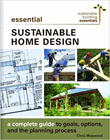
Sustainable Home Design:
A complete guide to goals, options, and the planning process

Reviewed by Kelly Hart
Sustainable Home Design by Chris Magwood is billed as “a complete guide to goals, options, and the design process,” and it does a pretty good job of delivering all of this. Designing any home is a major endeavor and designing one that would be considered sustainable is even more complex, because this introduces a fistful of criteria to filter through. This book helps with that filtering process.
What is meant by “sustainable” varies with emphasis, and this is where each designer must decide which aspects are of paramount importance. The very first thing to do when setting out on this venture is to precisely define your goals and criteria, and this will guide all of your other choices. There is one long chapter that will help you make these decisions.
Another chapter looks at rating systems and product guides that are popular in North America and Europe, such as LEED for Homes and Energy Star certification. The value of these systems and guides for helping with decision making is outlined. The book has developed a criteria matrix that can be used as a basis for evaluating the various aspects of house design.
There is a fairly detailed chapter on building science basics, a topic that Magwood has written an entire book about. These considerations are very important for designing homes that are comfortable, durable and energy efficient.
After goals and criteria have been established it is time to begin the design process, which ideally entails much careful thought and discussion before anything is committed to detailed plans. Many factors should be looked at, and Magwood suggests that developing a design team may be the best way to accomplish this. Whether you plan to engage in a total self design/build project or turn it all over to the professionals, you can benefit from learning from a variety of knowledgeable people. One chapter is devoted to how to develop such a design team.
The codes and regulatory system is something that most designers and builders must deal with. It is best to consider these aspects from the very beginning, so there are no surprises down the road. One very useful chapter discusses how to approach this and what outcomes to expect.
The last half of the book looks at all of the materials and systems that must be employed to create a modern home. Starting with the foundation and working upward to walls, floors, roofs, and mechanical systems. Common choices for each of these aspects is described and evaluated according to the criteria matrix presented earlier. This evaluation should help the designer make the most appropriate choices for his specific project.
The chapter on mechanical systems describes all of the basic provisions needed for utilities, and includes HVAC choices. While the various heating options are shown, there is no way presented to compare each of them for efficiency, which should be a major consideration.
In his concluding remarks, Magwood says, “We are, collectively, at the bottom edge of a learning curve to figure out how to maintain our current comfortable lifestyles while dramatically reducing our ecological impacts, our exposure to toxins, and our reliance on fossil fuels --- all with an eye toward resiliency in a rapidly changing world.” This book should help us on that path.

For Email contact go to About Us
Established in 2001, GreenHomeBuilding.com is primarily a labor of love. Kelly, and the GreenHomeBuilding team of experts, have answered thousands of questions for readers over the years, and we continue to publish up-to-date information about increasingly important sustainable architecture. If you feel moved to assist us in this work, your kind donation would be much appreciated; this can be easily done through our PayPal account:

VISIT OUR OTHER WEBSITES:
[Natural Building Blog] [Earthbag Building] [Dream Green Homes]
Disclaimer Of Liability And Warranty
I specifically disclaim any warranty, either expressed or implied, concerning the information on these pages. Neither I nor any of the advisor/consultants associated with this site will have liability for loss, damage, or injury, resulting from the use of any information found on this, or any other page at this site. Kelly Hart, Hartworks LLC.
